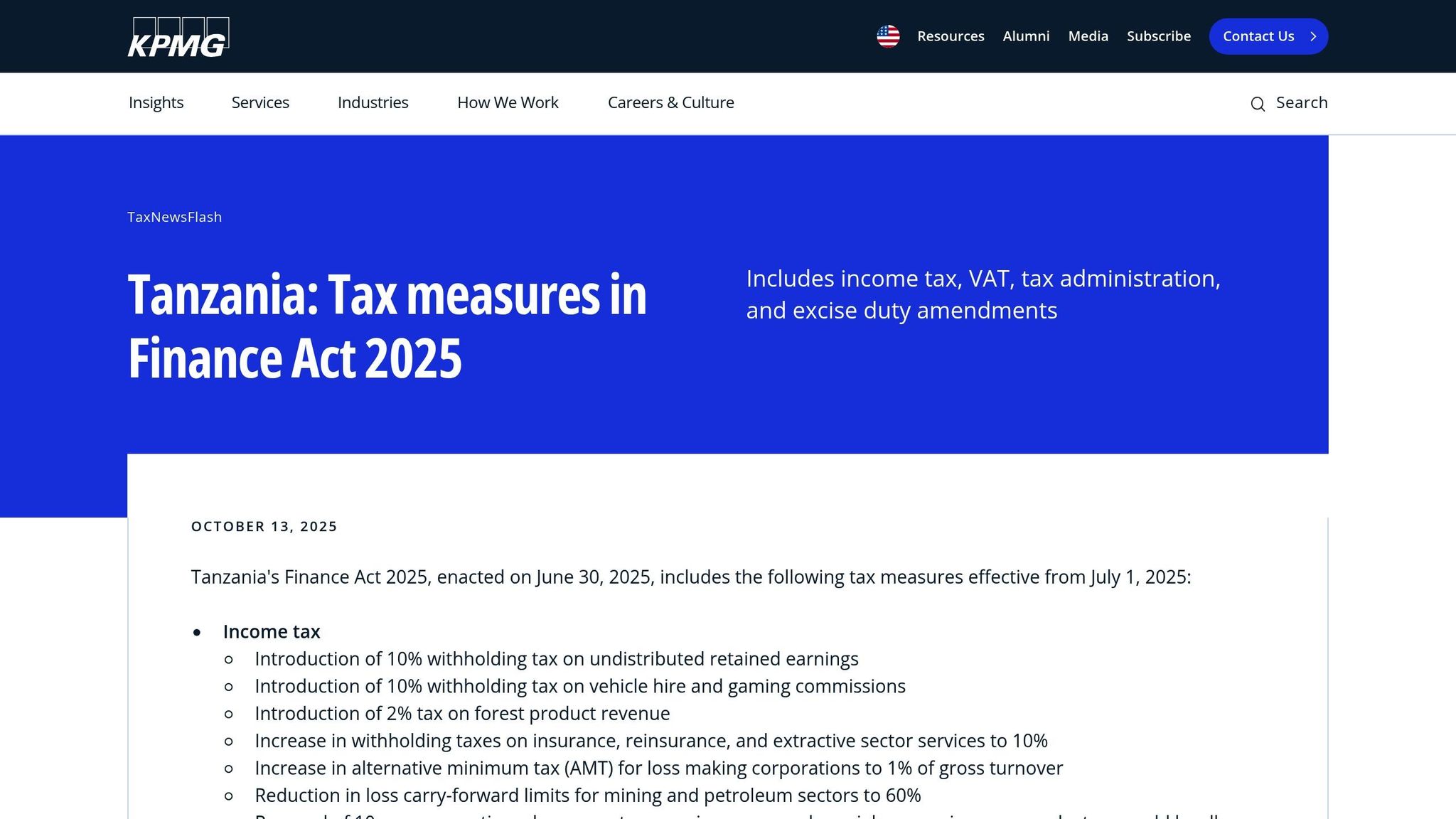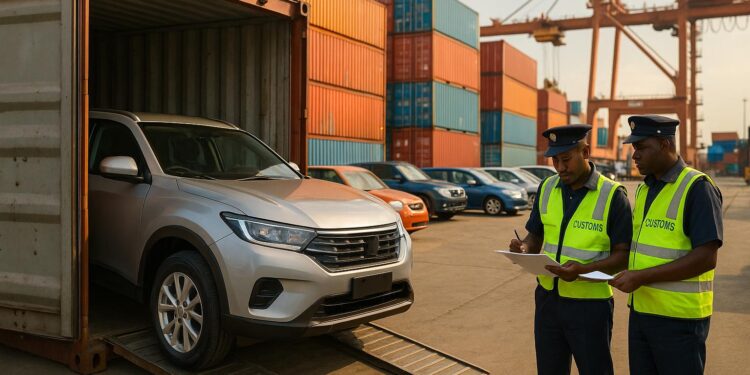Importing a vehicle to Tanzania in 2025 involves multiple taxes and fees that can significantly increase the total cost. Here’s what you need to know:
- Taxes and Fees: Import Duty, VAT (18%), Excise Duty (varies by age and engine size), Railways Development Levy (2% of CIF value), Destination Inspection Fee (0.6% of FOB value), and Motor Vehicle Registration Tax (TZS 50,000–250,000).
- Age-Based Duties: Vehicles over 10 years old face a 30% excise duty, while those under 5 years are exempt.
- Engine Size: Vehicles with engines above 2,000cc incur higher duties (up to 10%).
- New Rules: The Finance Act 2025 introduced stricter age and emission-related charges to discourage older, high-emission vehicles.
Key Tips:
- Choose vehicles under 5 years old to save on duties.
- Opt for smaller engine sizes (under 1,500cc) to minimize taxes.
- Work with a licensed clearing agent to navigate the process efficiently.
For a smooth experience, ensure compliance with all regulations, prepare documents in advance, and budget for additional fees like shipping and port handling.
Vehicle Import Regulations in Tanzania
Legal Framework and Vehicle Types
To navigate Tanzania’s vehicle import system, it’s essential to understand the regulations that govern it. While the government doesn’t outright ban older vehicles, it uses excise duties as a way to encourage importing newer models.
Starting July 1, 2025, stricter excise duty rates will apply. For example:
- Motorcycles over three years old and passenger vehicles older than five years will face a 10% excise duty.
- Vehicles aged between 8 and 10 years will incur a 15% rate.
- Those over 10 years old will be taxed at 30%.
Engine size also plays a significant role in determining import costs. Vehicles with engines between 1,000cc and 2,000cc will face a 5% duty, while those exceeding 2,000cc will be taxed at 10%.
Some vehicles qualify for special treatment. For instance, vehicles designated for official use by the armed forces are exempt from VAT. Additionally, all imported vehicles are subject to a Motor Vehicle Registration Tax, which ranges from TZS 50,000 to TZS 250,000 depending on the type and engine size, effective July 1, 2025.
Import Duties, Taxes, and Fees Breakdown
Import Duty, VAT, and Excise Duty
When bringing vehicles into Tanzania, importers are subject to import duty, VAT, and excise duty. The rates for these taxes depend on factors like the vehicle’s type, age, and engine capacity. To get accurate and up-to-date information, it’s essential to check with Tanzanian customs authorities. Beyond these core taxes, there are additional fees and levies that importers need to consider.
Other Levies and Fees
Apart from the primary taxes, several other charges come into play when importing vehicles:
- Motor Vehicle Registration Tax: This tax also contributes to the AIDS Trust Fund and the Universal Health Insurance Fund.
- Railways Development Levy (RDL): Calculated at 2% of the vehicle’s Cost, Insurance, and Freight (CIF) value.
- Destination Inspection Fee: A charge of 0.6% based on the Free On Board (FOB) value of the vehicle.
- Additional Fees: Costs for customs brokerage, port services, handling, and stevedoring may also apply. These charges can vary depending on the port and the specific service providers involved.
How to Import Used Japanese Cars to Tanzania – Complete
2025 Regulatory Updates and Changes
Tanzania’s vehicle import framework for 2025 comes with notable updates, refining the regulations already in place.
Finance Act 2025 Changes

Starting July 1, 2025, the Finance Act 2025 introduces adjustments to excise duties, targeting vehicle age, engine size, and spare parts. Here’s how the changes break down:
- Passenger Vehicles:
- Over five years old: 10% excise duty.
- Eight to ten years old: 15%.
- Older than ten years: 30%.
- Engine Capacity:
- Vehicles with engines between 1,000cc and 2,000cc: 5%.
- Vehicles exceeding 2,000cc: 10%.
- Spare Parts:
- A flat 25% duty now applies to spare parts for vehicles, motorcycles, and electrical appliances.
Additionally, carbon emission charges are on the horizon, though specific rates are yet to be announced. These updates clearly aim to discourage the import of older, less efficient vehicles, while promoting cleaner alternatives.
Age and Environmental Restrictions
The updated regulations also emphasize environmental concerns by imposing higher excise duties on older vehicles. Here’s a quick look at the new rates:
| Vehicle Age | Excise Duty Rate | Impact on Import Viability |
|---|---|---|
| Under 5 years | 0% | Most cost-effective option |
| 5–8 years | 10% | Moderate cost increase |
| 8–10 years | 15% | Significant cost barrier |
| Over 10 years | 30% | Often economically unfeasible |
These duties don’t stand alone – they’re combined with engine capacity charges. For example, a ten-year-old car with an engine larger than 2,000cc would face both a 30% duty based on age and an additional 10% for engine size. This dual system makes importing older, high-capacity vehicles increasingly expensive, pushing for a shift toward newer, eco-friendly options.
sbb-itb-d9186c2
How to Import Vehicles in Tanzania: Step-by-Step Process
Bringing a vehicle into Tanzania involves a structured process that helps streamline the experience and avoid unnecessary delays.
Step 1: Pre-Import Preparation
Before your vehicle even sets sail, ensure all shipping documents clearly state its specifications and value. It’s also wise to engage a licensed clearing agent in Tanzania early on. These professionals are well-versed in customs procedures and can provide you with cost estimates based on Tanzania Revenue Authority (TRA) valuations. Keep in mind, though, that final costs may differ after the official TRA assessment.
Once your paperwork is in order, you’ll be ready to move on to the customs clearance stage at the port.
Step 2: Customs Clearance Process
When your vehicle arrives at a Tanzanian port, your clearing agent will submit the necessary documents to the TRA for evaluation. Import duties and taxes are determined using the Cost, Insurance, and Freight (CIF) method, which takes into account the vehicle’s value and shipping expenses. TRA officials will also conduct their own valuation of the vehicle to confirm its worth.
Your clearing agent will handle payments for levies such as the Railways Development Levy, which is 2% of the CIF value, along with any other required fees. Once the customs clearance process is finalized, you can proceed to the registration and tax payment stage.
Step 3: Final Registration and Tax Payment
After clearing customs, the next step is settling any outstanding taxes. This includes Value-Added Tax (VAT), which is due at the time of importation, as well as any remaining customs and excise duties. You’ll also need to pay the Motor Vehicle Registration Tax, which is calculated based on current rates.
To complete the registration process, present your customs clearance documents and proof of tax payments to the TRA or your clearing agent. Don’t forget to arrange for local insurance coverage before driving your vehicle on Tanzanian roads.
For the most accurate information on duties and requirements, visit the TRA’s website at www.tra.go.tz or consult a licensed clearing agent.
Tips for Reducing Import Costs
Lowering import costs in Tanzania requires careful planning and smart choices, especially when selecting a vehicle. By understanding how taxes are applied, you can make decisions that help cut down expenses. Here are some strategies to keep in mind.
Choosing Cost-Effective Vehicles
Engine size plays a big role. Vehicles with engines of 1,000cc or less come with lower – or even no – excise duties. Opting for models in this category can lead to noticeable savings.
The age of the vehicle affects taxes. Passenger vehicles that are less than 5 years old and motorcycles under 3 years old are subject to lower excise duties compared to older models.
Lower emissions can mean lower costs. According to the Finance Act 2025, excise duties are now tied to carbon emissions. Vehicles with lower emissions are not only better for the environment but also easier on your wallet.
Key Takeaways for Vehicle Imports in 2025
Importing vehicles into Tanzania in 2025 comes with a host of financial and regulatory considerations. The actual cost of an imported vehicle goes well beyond its sticker price, thanks to import duties, VAT, and excise taxes.
Engine capacity and vehicle type play a major role in determining these costs. For instance, vehicles with engines under 1,500cc are exempt from excise duty, while those exceeding 2,500cc are hit with a 15% excise rate. Additionally, passenger vehicles are subject to a 25% import duty, compared to 15% for commercial vehicles.
Age restrictions have become more stringent. Used passenger cars must now be no older than 10 years, while vehicles imported from Japan are capped at 8 years. Exceeding these limits can result in dumping fees of up to 30%.
Environmental standards also affect costs. Hybrid vehicles and those meeting Euro-6 standards may qualify for green rebates ranging from 5% to 10%, making them more economical choices.
Documentation and compliance are non-negotiable. Pre-shipment inspection certificates from agencies like JEVIC or QISJ are mandatory to avoid delays, fines, or outright rejection at customs. Right-hand drive vehicles are generally the only ones allowed, and every import must pass emissions and roadworthiness tests before registration.
Working with authorized agents can simplify the process. They can assist with inspections, calculate duties, and handle paperwork. Online tools like duty calculators or professional clearing agents are also helpful for estimating costs.
Keep in mind that additional fees – such as the Railway Development Levy, wharfage, and processing fees – can significantly drive up expenses. When combined with shipping, port handling, and registration fees, the total costs often surpass the vehicle’s original purchase price.
Successfully importing a vehicle in 2025 requires careful planning, strict adherence to regulations, and a realistic budget that accounts for all associated costs. These insights highlight the key factors to consider for a smooth and cost-effective import experience.
FAQs
What are the best ways to save money when importing a vehicle to Tanzania in 2025?
To save money when importing a vehicle to Tanzania in 2025, here are some strategies to keep in mind:
- Consider electric vehicles (EVs): EVs are a smart choice since they come with lower import taxes – just 45%, compared to the 50–65% range for conventional vehicles. They may also qualify for excise duty exemptions, adding to your savings.
- Utilize tax exemptions: Look into exemptions available for EVs or for returning residents bringing in personal vehicles. These can significantly cut down costs.
- Adhere to age restrictions: For 2025, imported vehicles must meet the age limit requirements. For EVs, this means the vehicle needs to be manufactured in 2017 or later (8 years old or newer).
- Organize your paperwork: Ensure all required documents are complete and accurate before heading to customs. This step can help avoid unnecessary delays, penalties, or extra fees.
By staying informed about these rules and preparing ahead, you can effectively lower your import costs.
What changes does the Finance Act 2025 introduce for importing older vehicles into Tanzania?
The Finance Act 2025 introduces an 8-year age limit on imported vehicles. If a vehicle exceeds this age, it will be subject to additional fines, significantly increasing the cost of importing older models.
For those looking to import a car, it’s wise to choose newer models to sidestep these penalties and align with the updated regulations. Keeping up with customs rules not only helps you avoid extra costs but also simplifies the entire import process.
How can I reduce import duties on vehicles in Tanzania by choosing the right engine size and emissions level?
To reduce import duties in Tanzania, consider choosing vehicles with smaller engine capacities, particularly those under 2,000cc. Larger engines typically incur higher excise taxes, which can reach about 10%. Additionally, vehicles with lower emissions that meet Euro 4 standards are taxed at a lower rate. Electric vehicles that meet Euro 4 standards and are less than 8 years old often benefit from reduced or even zero import duties, along with VAT exemptions and lower overall taxes. These choices can lead to substantial savings when importing a vehicle.
Related Blog Posts
- Duty-Free Vehicle Import Rules in Tanzania
- Car prices in Dar es Salaam
- Car registration costs in Tanzania




